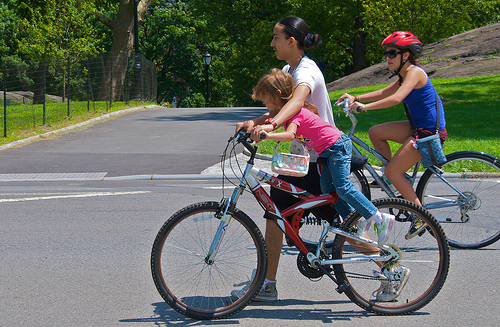It may now be safe for cyclists who want to get some exercise -- as opposed to waiting for lights to turn green or for officers to finish writing $270 tickets -- to return to Central Park.
At a meeting Wednesday night with representatives of groups that use the park's loop road, the Central Park Precinct's Community Affairs Officer Richard Tombari strongly implied that the precinct's enforcement approach has shifted from its previous and punitive zero-tolerance stance.
While stressing that "the law is the law" and that cyclists will never get an official announcement of relaxed enforcement, Tombari told meeting attendees that officers have "discretion" and that their focus is now on reckless cycling. He offered several examples of what might be considered reckless riding, including racing through a red light when pedestrians are in the crosswalk. None of his examples involved a cyclist riding through a red light when no one is attempting to cross. It was unclear whether officers' use of discretion is limited to car-free hours or whether it extends to places and times when cars are in the park.
Tombari's comments came during a meeting of the Central Park Conservancy's Recreation Roundtable, a loosely structured advisory group that works with the Conservancy on recreation issues in the park. Supporting the suggestion of a more relaxed enforcement regime is the fact that none of the representatives of the cycling organizations in the room knew of a red-light summons having been issued to a cyclist in the park in the past several weeks. In addition, on April 6, citing a reliable source, the New York Cycle Club announced to its members that a pilot program is underway in which the police will not enforce red lights in Central Park between the hours of 6:00 a.m. and 8:00 a.m. on weekdays, barring reckless or dangerous riding. At the same time, the lights on the loop road were permanently synchronized to 25 miles per hour, presumably as an accommodation to fast cyclists.
While it appears that cyclists will never get explicit confirmation from the NYPD, after Wednesday's meeting it seems fair to conclude that the NYPD is now pursuing a more rational policy of focusing enforcement on reckless cycling and is unlikely to ticket cyclists riding through red lights at deserted intersections, at least when that section of the loop is car-free. A meeting attendee asked about trends in the enforcement of rules against counterflow riding on the drives and equipment violations, and Tombari said he would provide a response.
But as long as the NYPD is unwilling to explicitly pledge that it will not ticket cyclists simply because they go through a red light -- or as long as the city insists that traffic laws apply to cyclists in parks during car-free hours -- riding a bike in Central Park remains, legally speaking, a dicey proposition. (Dicey, that is, unless you can maintain an average speed of 25 mph, which seems like a crazy thing for anyone to be encouraging at this point.) Changing the lights to flashing yellow during car-free times, as legislation introduced by City Council Member Ydanis Rodriguez calls for, appears to be the only current route for legitimizing recreational cycling in the park once more. Rodriguez's bill now has 11 co-sponsors, although the Department of Transportation reportedly opposes it on the grounds that it would confuse pedestrians.
Will the "Central Park Shuffle" – a ticket-avoidance strategy employed by some in which the rider dismounts and runs through the red light cyclocross-style – become a vaguely remembered relic of a fleeting period of civic madness? Perhaps, but you might not want to clip in too tightly just yet.
Steve Vaccaro assisted with reporting and writing.






